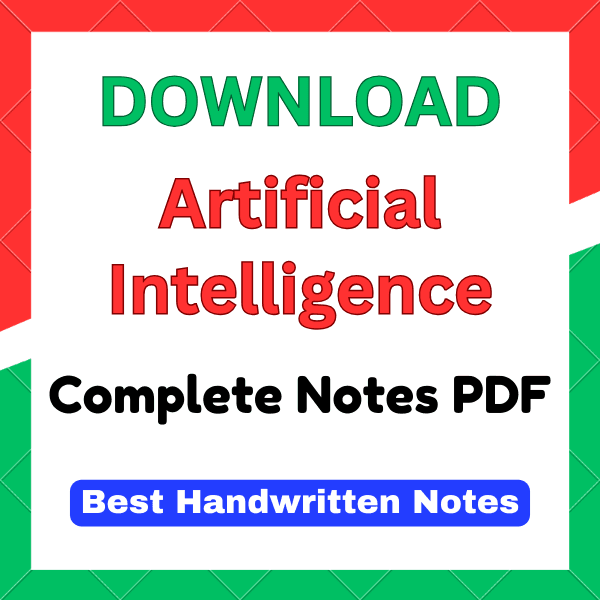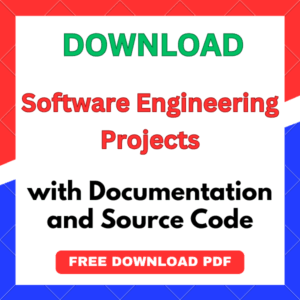Artificial Intelligence Handwritten Notes PDF Download
Free artificial intelligence handwritten notes pdf are provided here for Artificial Intelligence students so that they can prepare and score high marks in their Artificial Intelligence exam.
In these free AI handwritten notes pdf, we will study the basic concepts and techniques of Artificial Intelligence (AI). The aim of these artificial intelligence notes pdf is to introduce intelligent agents and reasoning, heuristic search techniques, game playing, knowledge representation, reasoning with uncertain knowledge.
We have provided complete artificial intelligence handwritten notes pdf for any university student of BCA, MCA, B.Sc, B.Tech CSE, M.Tech branch to enhance more knowledge about the subject and to score better marks in their Artificial Intelligence exam.
Free artificial intelligence pdf notes are very useful for Artificial Intelligence students in enhancing their preparation and improving their chances of success in Artificial Intelligence exam.
These free artificial intelligence notes pdf will help students tremendously in their preparation for Artificial Intelligence exam. Please help your friends in scoring good marks by sharing these free AI hand written notes pdf from below links:
Topics in our Artificial Intelligence Handwritten Notes PDF
The topics we will cover in these Artificial intelligence handwritten notes pdf will be taken from the following list:
Artificial Intelligence Introduction
- Definitions: Artificial Intelligence, Intelligence, Intelligent behavior, Understanding AI, Hard or Strong AI, Soft or Weak AI, Cognitive Science.
- Goals of AI: General AI Goal, Engineering based AI Goal, Science-based AI Goal.
- AI Approaches: Cognitive science, Laws of thought, Turing Test, Rational agent.
- AI Techniques: Techniques that make the system behave as Intelligent, Describe and match, Goal reduction, Constraint satisfaction, Tree Searching, Generate and test, Rule-based systems.
- Biology-inspired AI Techniques: Neural Networks, Genetic Algorithms, Reinforcement learning.
- Branches of AI: Logical AI, Search in AI, Pattern Recognition, Knowledge Representation, Inference, Commonsense knowledge and reasoning, Learning, Planning, Epistemology, Ontology, Heuristics, Genetic programming.
- Applications of AI: Game playing, Speech Recognition, Understanding Natural Language, Computer Vision, Expert Systems.
Problem Solving, Search Strategies
- General Problem Solving Problem solving definitions: problem space, problem-solving, state space, state change, the structure of state space, problem solution, problem description; Examples of problem definition.
- Search and Control Strategies Search related terms: algorithm’s performance and complexity, computational complexity, “Big – O” notations, tree structure, stacks, and queues; Search: search algorithms, hierarchical representation, search space, the formal statement, search notations, estimate cost, and heuristic function; Control strategies: strategies for search, forward and backward chaining.
- Exhaustive Searches Depth-first search Algorithm; Breadth-first search Algorithm; Compare depth-first and breadth-first search;
- Heuristic Search Techniques Characteristics of heuristic search; Heuristic search compared with another search; Example of heuristic search; Types of heuristic search algorithms
- Constraint Satisfaction Problems (CSPs) and Models Examples of CSPs; Constraint Satisfaction Models: Generate and Test, Backtracking algorithm, Constraint Satisfaction Problems (CSPs): definition, properties, and algorithms.
Knowledge Representation
- Knowledge Representation Introduction – Knowledge Progression, KR model, category: typology map, type, relationship, framework, mapping, forward & backward representation, KR system requirements; KR schemes – relational, inheritable, inferential, declarative, procedural; KR issues – attributes, relationship, granularity.
- KR Using Predicate Logic Logic as language; Logic representation: Propositional logic, statements, variables, symbols, connective, truth value, contingencies, tautologies, contradictions, antecedent, consequent, argument; Predicate logic – predicate, logic expressions, quantifiers, formula; Representing “IsA” and “Instance” relationships; Computable functions and predicates; Resolution.
- KR Using Rules Types of Rules – declarative, procedural, meta-rules; Procedural versus declarative knowledge & language; Logic programming – characteristics, statement, language, syntax & terminology, Data components – simple & structured data objects, Program Components – clause, predicate, sentence, subject, queries; Programming paradigms – models of computation, imperative model, functional model, logic model; Reasoning – Forward and backward chaining, conflict resolution; Control knowledge.
Reasoning System
- Reasoning: Definitions Reasoning, formal logic, and informal logic, uncertainty, monotonic logic, non-monotonic Logic; Methods of reasoning and examples – deductive, inductive, abductive, analogy; Sources of uncertainty; Reasoning and KR; Approaches to reasoning – symbolic, statistical, and fuzzy.
- Symbolic Reasoning: Non-monotonic reasoning – Default Reasoning, Circumscription, Truth Maintenance Systems; Implementation issues.
- Statistical Reasoning: Glossary of terms; Probability and Bayes’ theorem – probability, Bayes’ theorem, examples; Certainty factors rule-based systems; Bayesian networks and certainty factors – Bayesian networks; Dempster Shafer theory – model, belief and plausibility, calculus, combining beliefs; Fuzzy logic – description, membership.
Game Theory
- Overview Definition of Game, Game theory, Relevance of Game theory and Game plying, Glossary of terms – Game, Player, Strategy, Zero-Sum game, Constant-Sum game, Nonzero-Sum game, Prisoner’s dilemma, N-Person Game, Utility function, Mixed strategies, Expected payoff, Mini-Max theorem, Saddle point; Taxonomy of games.
- Mini-Max Search Procedure Formalizing game: General and a Tic-Tac-Toe game, Evaluation function; MINI-MAX Technique: Game Trees, Mini-Max algorithm.
- Game Playing with Mini-Max Example: Tic-Tac-Toe – Moves, Static evaluation, Back-up the evaluations, Evaluation obtained.
- Alpha-Beta Pruning Alpha-cutoff, Beta-cutoff
Learning System
- What is Learning Definition, learning agents, components of the learning system; Paradigms of machine learning.
- Rote Learning Learning by memorization, Learning something by repeating.
- Learning from Example: Induction Winston’s learning, Version spaces -learning algorithm (generalization and specialization tree), Decision trees – ID3 algorithm.
- Explanation Based Learning (EBL) General approach, EBL architecture, EBL system, Generalization problem, Explanation structure.
- Discovery Theory drove – AM system, Data-driven – BACON system
- Clustering Distance functions, K-mean clustering – algorithm.
- Analogy: Neural net and Genetic Learning Neural Net – Perceptron; Genetic learning – Genetic Algorithm.
- Reinforcement Learning RL Problem: Agent – environment interaction, key Features; RL tasks, Markov system, Markov decision processes, Agent’s learning task, Policy, Reward function, Maximize reward, Value functions.
Expert Systems
- Introduction Expert system components and human interfaces, expert system characteristics, expert system features.
- Knowledge Acquisition Issues and techniques.
- Knowledge Base Representing and using domain knowledge – IF-THEN rules, semantic network, frames.
- Working Memory
- Inference Engine Forward chaining – data-driven approach, backward chaining – goal-driven approach, tree searches – DFS, BFS.
- Expert System Shells Shell components and description.
- Explanation Example, types of explanation
- Application of Expert Systems
Neural Networks
- Introduction Why neural network ?, Research history, Biological neuron model, Artificial neuron model, Notations, Functions.
- Model of Artificial Neuron McCulloch-Pitts Neuron Equation, Artificial neuron – basic elements, Activation functions – threshold function, piecewise linear function, sigmoidal function.
- Neural Network Architectures Single-layer feed-forward network, Multilayer feed-forward network, Recurrent networks.
- Learning Methods in Neural Networks Classification of learning algorithms, Supervised learning, Unsupervised learning, Reinforced learning, Hebbian Learning, Gradient descent learning, Competitive learning, Stochastic learning.
- Single-Layer NN System Single-layer perceptron: learning algorithm for training, linearly separable task, XOR Problem, learning algorithm; ADAptive LINear Element (ADALINE): architecture, training mechanism
- Applications of Neural Networks Clustering, Classification/pattern recognition, Function approximation, Prediction systems.
Fundamentals of Genetic Algorithms
- Introduction Why genetic algorithms, Optimization, Search optimization algorithm; Evolutionary algorithm (EAs); Genetic Algorithms (GAs): Biological background, Search space, Working principles, Basic genetic algorithm, Flow chart for Genetic programming.
- Encoding Binary Encoding, Value Encoding, Permutation Encoding, and Tree Encoding.
- Operators of Genetic Algorithm Reproduction or selection: Roulette wheel selection, Boltzmann selection; fitness function; Crossover: one-Point crossover, two-Point crossover, uniform crossover, arithmetic, heuristic; Mutation: flip bit, boundary, non-uniform, uniform, Gaussian.
- Basic Genetic Algorithm Solved examples: maximize function f(x) = x2 and two bar pendulum.
Natural Language Processing
- Introduction Natural language: Definition, Processing, Formal language, Linguistic and language processing, Terms related to linguistic analysis, Grammatical structure of utterances – sentence, constituents, phrases, classifications, and structural rules.
- Syntactic Processing: Context-free grammar (CFG) – Terminal, Non-terminal, and start symbols; Parser.
- Semantic and Pragmatic
AI Common Sense
- Introduction Common sense knowledge and reasoning, How to teach commonsense to a computer.
- Formalization of Common Sense Reasoning Initial attempts of late 60’s and early, Renewed attempts in late 70’s and 80’s to recent times.
- Physical World Modeling the qualitative world, Reasoning with qualitative information.
- Common Sense Ontologies Time, Space, Material.
- Memory Organization Short term memory (STM), Long term memory (LTM).
Artificial Intelligence PDF Notes FREE Download
Artificial Intelligence students can easily make use of all these complete artificial intelligence handwritten notes pdf by downloading them from below links:

Artificial Intelligence Handwritten Notes pdf by Deepak

AI handwritten notes pdf by Riya

Artificial Intelligence notes pdf by Abhishek

Artificial Intelligence pdf notes free download

AI notes pdf for MCA

Handwritten AI notes PDF
Source: nptel.ac.in

Artificial Intelligence bca notes PDF
Source: iitkgp.ac.in

Artificial Intelligence notes for bca pdf
Source: iitk.ac.in

Artificial Intelligence mca notes pdf
Source: iitb.ac.in

Artificial Intelligence pdf notes free download
Source: niecdelhi.ac.in

Artificial Intelligence notes pdf free download
Source: researchgate.net

AIML notes pdf
Source: tutorialspoint.com

Artificial Intelligence notes pdf
Source: ocw.mit.edu

AI hand written notes pdf for cse
Source: eecs.wsu.edu

Artificial Intelligence handwritten notes pdf free download
Source: uni-regensburg.de
How to Download FREE AI Handwritten Notes PDF?
Artificial Intelligence students can easily download free artificial intelligence handwritten notes pdf by following the below steps:
- Visit TutorialsDuniya.com to download free artificial intelligence handwritten notes pdf
- Select ‘College Notes’ and then select ‘Computer Science Course’
- Select ‘AI handwritten notes pdf’
- Now, you can easily view or download free artificial intelligence notes pdf
Artificial Intelligence Books
We have listed the best Artificial Intelligence Reference Books that can help in your AI exam preparation:
Benefits of FREE Artificial Intelligence Notes PDF
Free artificial intelligence handwritten notes pdf provide learners with a flexible and efficient way to study and reference Artificial Intelligence concepts. Benefits of these complete free AI hand written notes pdf are given below:
- Accessibility: These free artificial intelligence notes pdf files can be easily accessed on various devices that makes it convenient for students to study Artificial Intelligence wherever they are.
- Printable: These artificial intelligence handwritten notes pdf can be printed that allows learners to have physical copies of their AI notes pdf for their reference and offline reading.
- Structured content: These free artificial intelligence pdf notes are well-organized with headings, bullet points and formatting that make complex topics easier to follow and understand.
- Self-Paced Learning: Free handwritten AI notes pdf offers many advantages for both beginners and experienced students that make it a valuable resource for self-paced learning and reference.
- Visual Elements: These free AI handwritten notes pdf include diagrams, charts and illustrations to help students visualize complex concepts in an easier way.
We hope our free artificial intelligence notes pdf has helped you and please share these free artificial intelligence handwritten notes pdf with your friends as well
Download FREE Study Material App for school and college students for FREE high-quality educational resources such as notes, books, tutorials, projects and question papers.
If you have any questions feel free to reach us at tutorialsduniya@gmail.com and we will get back to you at the earliest.
TutorialsDuniya.com wishes you Happy Learning!
Computer Science Notes
Artificial Intelligence Notes FAQs
Q: Where can I get complete artificial intelligence handwritten notes pdf free download?
A: TutorialsDuniya.com have provided complete artificial intelligence handwritten notes pdf so that students can easily download and score good marks in your Artificial Intelligence exam.
Q: How to download ai handwritten notes pdf?
A: Artificial Intelligence students can easily make use of all these complete free ai handwritten notes pdf by downloading them from TutorialsDuniya.com
Software Engineering Projects with Documentation & Source

You will always find the updated list of top and best free software engineering projects with documentation and source code pdf in an easy and quick way. Our Free software engineering projects with source code list has projects for beginners, intermediates as well as experts to learn in 2023.
URL: https://tutorialsduniya.com/software-engineering-projects-pdf/
Author: Delhi University
5














